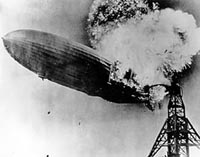The Hindenburg Tragedy: May 6, 1937

The fiery explosion on May 6, 1937
 ON MAY 6, 1937, the German airship Hindenburg burst into flames 200 feet over its intended landing spot at New Jersey's Lakehurst Naval Air Station. Thirty-five people on board the flight were killed (13 passengers and 22 crewmen), along with one crewman on the ground. ON MAY 6, 1937, the German airship Hindenburg burst into flames 200 feet over its intended landing spot at New Jersey's Lakehurst Naval Air Station. Thirty-five people on board the flight were killed (13 passengers and 22 crewmen), along with one crewman on the ground.803 Feet Long and 242 Tons The giant flying vessel measured 803.8 feet in length and weighed approximately 242 tons. Its mostly metal frame was filled with hydrogen. It came complete with numerous sleeping quarters, a library, dining room, and a magnificent lounge, but still managed a top speed of just over 80 miles per hour. The zeppelin had just crossed the Atlantic Ocean after taking off from Frankfurt, Germany 2½ days prior on its first transatlantic voyage of the season. Thirty-six passengers and a crew of 61 were on board. Disaster StrikesAs it reached its final destination in New Jersey, it hovered over its landing spot and was beginning to be pulled down to the ground by landing lines by over 200 crewmen when disaster struck. A small burst of flame started just forward of the upper fin, then blossomed into an inferno that quickly engulfed the Hindenburg's tail.
Many jumped from the burning craft, landed on the soft sand of the naval base below, and lived to tell about it; others weren't so lucky. Herb Morrison, a reporter for WLS Radio in Chicago, happened to be covering the event and cried out the now famous words, "Oh, the Humanity!" The majestic ship turned into ball of flames on the ground in only 34 seconds. Unknown CauseThe cause of the disaster is still uncertain. At the time, many thought the ship had been hit by lightning. Many still believe that the highly flammable hydrogen was the cause. Some Germans even cried foul play, suspecting sabotage intended to sully the reputation of the Nazi regime. NASA research, however, has shown that the highly combustible varnish treating the fabric on the outside of the vessel most likely caused the tragedy. |
